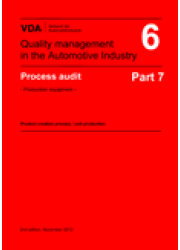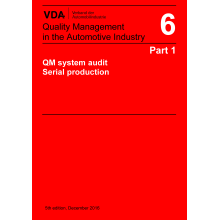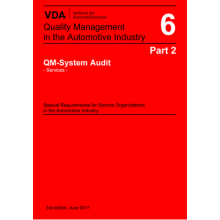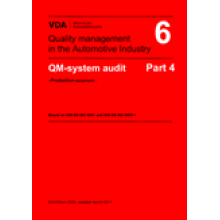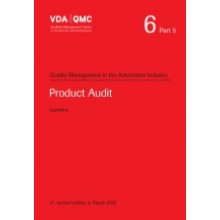VDA 6 Part 7 Process Audit - Production equipment - Product creation process / unit production 2nd edition, November 2012
Quantity:
Add to Compare
In many areas of the economy these days, a "comprehensive" quality management system is an integral part of the company strategy and creates the organisational conditions required in order to meet high quality demands on products and processes. System audits are carried out at planned intervals, to check the effectiveness of the quality management systems.
Ever shorter time spans, from the initial concept to the new product or service, ready for the market, constantly demand greater parallel execution of work sequences and operations in a wide range of areas of the company. This means that greater demands are placed on the processes.
Checks by the operators themselves and reductions in the amount of inspection, while still meeting increasing quality requirements, can be achieved only by the use of capable and controlled processes.
Of course, this applies to the product creation process & production / the service creation process & provision of the service.
Company processes must be monitored constantly in order to ensure their reliability and to introduce prompt control mechanisms and corrective action if non-conformances are detected.
Notes regarding the revision of 2012:
In association with the up-dating of publications VDA 6.2 and 6.4 in 2011 and in view of the adjustments to DIN EN ISO 9001:2008, the terms used in this present publication have been aligned accordingly.
In section 7 "Evaluation" the classifications and rules covering downgrading have been harmonized with VDA Band 6.3 "Process audit“ and forms 1 and 2 in section 13 have been adapted accordingly.
References to standards and addresses have been up-dated.
1 Objective and purpose of the publication
2 The association between system, process and product audits
3 Stipulations regarding process audits
3.1.3 Continuous improvement process
3.2.2 Unplanned process audits
3.4.1 Basic requirements within the organisation
3.4.2 Qualification of auditors
3.4.2.1 Technical training
3.4.2.2 Professional experience
3.4.2.3 Audit experience and maintaining qualification
3.4.3.1 Responsibilities of the auditing organisation / functional unit
3.4.3.2 The auditor's responsibilities
3.4.3.3 Responsibilities of the audited organisation / functional unit
5.2 Process limitation, process breakdown, process documents
5.3 Process-specific audit questionnaire / detailed audit
Sequence plan
6.1 Introductory meeting
6.2 The audit sequence
7.1 Individual evaluation of processes and their characteristics
7.2 Overall evaluation of the audit result
7.3 Classification
9 Corrective actions and checks on effectiveness
9.1 Corrective actions
9.2 Checks on effectiveness
10 Audit report and documentation
11 List of requirements for the process audit
11.2 Structure
11.3 Process characteristics
11.4 Requirements / explanations
Process 1: Project management
Process 2: Product development
Process 3: Sourcing
Process 4: Production
Process 5: Processes after shipment
12 Reference matrix VDA 6.7 – VDA 6.4
13 Process audit forms
Copyright © 2014 Engineering Standards Bureau. All Rights Reserved.
Developed By Zoom Into Web


